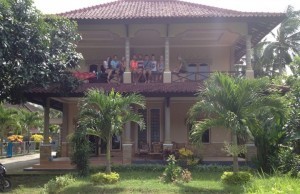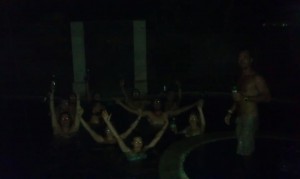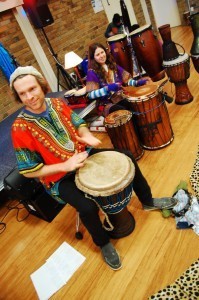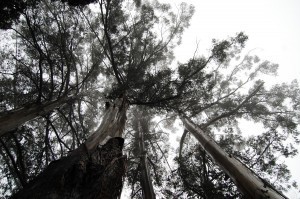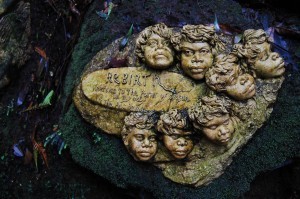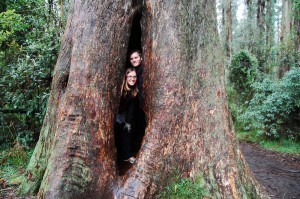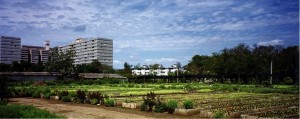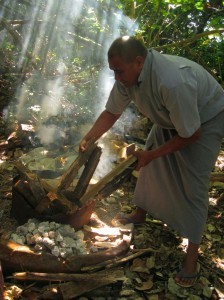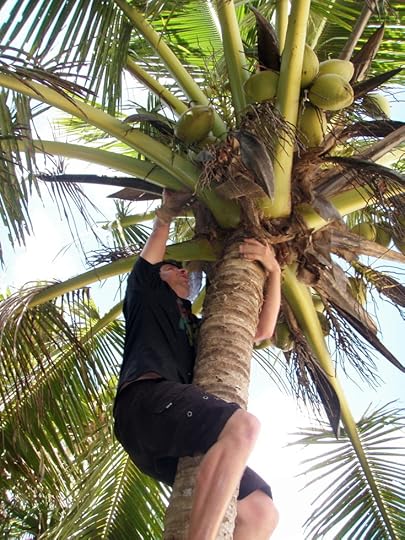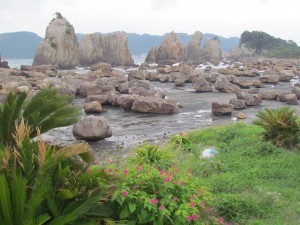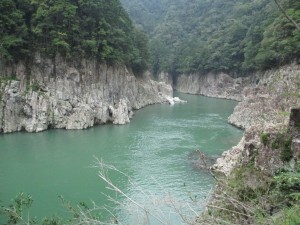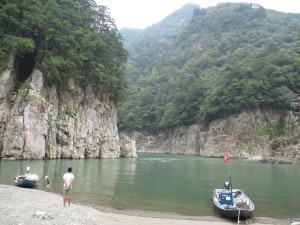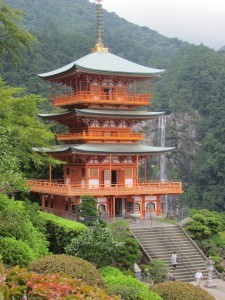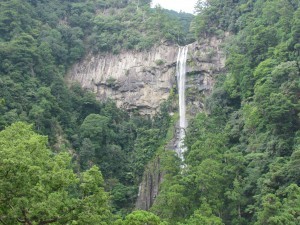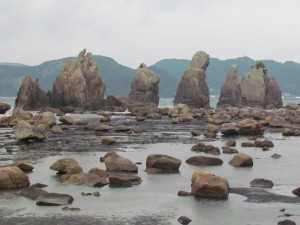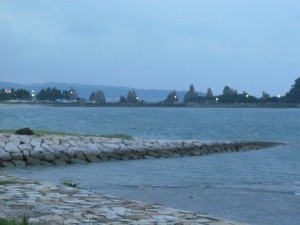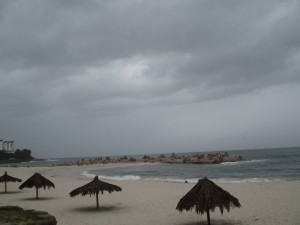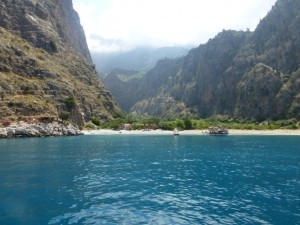Lisa Niver's Blog: We Said Go Travel, page 464
October 2, 2013
Los Angeles: Travel Happy Hour: Living without Regret
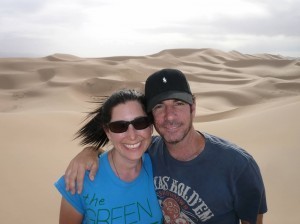 Travel Happy Hour:
Living without Regret
Travel Happy Hour:
Living without Regret
Have you dreamed of long-term international travel in Asia? Considered quitting your job to become a travel blogger and book writer? Want to connect with travel-minded community members?
Festival of the Pacific is a celebration of travel and transformation hosted by PennClubLA, LACOT, Dave’s Travel Corner, and We Said Go Travel. The theme, “Living Without Regret: Travel, Love and Success: Make your Dreams a Reality,” is presented by the founders of We Said Go Travel, Penn graduate Lisa Niver Rajna (C’89) and her husband George Rajna, who will give an inside look into their long-term exotic international travel across Asia over the last fifteen months. They will share their travel expertise, read an excerpt from their new memoir, “Traveling in Sin,” and provide information about We Said Go Travel’s writing contest, and upcoming community.
Join us for conversation, drinks and a raffle, at the Luxe Sunset Boulevard Hotel on October 16, at 7:00 PM.
11461 Sunset Boulevard
Los Angeles, CA 90049 USA
RSVP TODAY! with Penn Club LA or Facebook
Everyone is welcome and this event is free to attend.
Join us Oct 23rd for an online webinar on Exotic Burma!
Traveling in Sin is a HOT NEW Release on Amazon! from Lisa Niver Rajna
The post Los Angeles: Travel Happy Hour: Living without Regret appeared first on We Said Go Travel.
October 1, 2013
Guatemala: Tantalizing Tajumulco
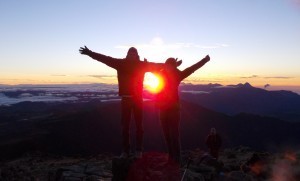 “You are my problem trekker,” smirked Lukas in a thick Czech Republican accent. Nodding in agreement, I knew I was their quarrelsome guest. Showing up hours past the first meeting will undoubtedly put a person into that mold. It was beyond my control, due to a nice surprise from my ‘legitimate’ Mexico-to-Guatemala bus company, which preferred dropping me off on the side of a random Guatemalan road, instead of at my destination. Hitchhiking via chicken bus, I managed to make my way into Quetzaltenango (Xela) in time to for Lukas to quickly run around gathering negated gear for my trek. He was obviously rushed time-wise, but I didn’t care, due to his memorizing pale blue eyes and eastern European twang. Czech accents sound similar to that of Arnold Schwarzenegger’s, except infinitely sexier.
“You are my problem trekker,” smirked Lukas in a thick Czech Republican accent. Nodding in agreement, I knew I was their quarrelsome guest. Showing up hours past the first meeting will undoubtedly put a person into that mold. It was beyond my control, due to a nice surprise from my ‘legitimate’ Mexico-to-Guatemala bus company, which preferred dropping me off on the side of a random Guatemalan road, instead of at my destination. Hitchhiking via chicken bus, I managed to make my way into Quetzaltenango (Xela) in time to for Lukas to quickly run around gathering negated gear for my trek. He was obviously rushed time-wise, but I didn’t care, due to his memorizing pale blue eyes and eastern European twang. Czech accents sound similar to that of Arnold Schwarzenegger’s, except infinitely sexier.
Lukas, and a few other traveling guides, volunteered for a company called Quetzaltrekkers. Successfully based out of Guatemala and Nicaragua, this organization is very unique in the world. Aimed at self-sustainability and turning tourism dollars into positive outlets, it adopted the slogan “Hike and Help”. Quetzaltrekkers is a non-profit, based on the help of gracious traveling volunteers. Trek costs and tips are purely donated to charities aimed at helping Guatemalan communities, specifically local children.
Finally, forms and packing preparations were complete, the only obligations left were to celebrate the first night in Xela, and arrive by 4:30am to start on our journey. My dear, hometown Montana friend, Aaron, was the person who invited me to climb Tajumulco, Central America’s highest peak. Rejoicing with Aaron and his Celas Maya Language school friends was much more comforting than I expected Guatemala to be. Before leaving the Yucatan Peninsula, my original solo backpacking base, I was constantly warned of the dangers lying within the country south of Mexico’s border. Xela instantly denounced all prior angst with its cultural soul, layered between architecture of past centuries and welcoming energy. The night of Quetzal-bliss turned into an abrupt morning wake up. If it wasn’t for brown sugar water (dubbed as coffee) and Aaron, I’m not sure if I would have even made it to Tajumulco’s base.
From that point on the only choice was up. The sweaty, steep incline, and hours devoted to mindlessly putting one-foot-in-front-of-the-other, were properly matched with the trek benefits; continuous breathtaking views, a tasty lunch break, uplifting prelusive talks with other trekkers, a random jam-session from locals, and our high-elevation base camp destination of the day. Prior to dinner we hiked to the second highest peak, Cerro Concepcion, to watch the most memorable sunset of my life. There was no distraction from the group, only pure devotion to the distant sun departing its golden sky to dive through a layer of crimson clouds, and dip into a modest crisp of the Pacific.
The awing sets of colors were eventually contrasted by gleaming black and white constellations that took over the sky, this acted as a guide back to our tents. That night transformed into a hard sleep in the midst of Central America’s highest canopy. In a few well rested hours I awoke to the same darkness; a slow kaleidoscope of stars beckoned our grumbling group’s way along the last crater ascent. The top of Tajumulco was nothing but frigid at 4,222 meters. While waiting for the sun to warmly peak over Guatemala’s volcanic highlands we distracted ourselves with hugs, jumping jacks, and the site of Lava on a distant peak.
I was beginning to internally coincide with Jack’s final moments on The Titanic, when the first beams of sunlight poured over the rugged silhouette. Our cold triumph was cheered on from all trekkers, we did not just happen to watch the world turn from this unique location, we fought for this opportunity. Time calmed our trepidation and brought for our descent for coffee, breakfast, and sadly, civilization. We worked down the mountain smiling and satisfied. The decline harmonized my feelings of personal achievement and reassurement of following a rambling wanderlust life. While riding back to town on love-themed chicken bus, astonishment and group-achievement laced our goodbyes to one another. I felt nothing but bliss at how devoted, inspiring, challenging and humbling this world and its various occupants truly are.
About the Author: My name is Jordan, I am a freshly addicted to this incredible passion of backpacking and traveling. Cultural anthropology, archaeology, and all-out adventures motivate me to see as much of this world that I can. I am solo traveler wanting to share my experiences with you, follow me at my new blog: www.jordisphere.com
The post Guatemala: Tantalizing Tajumulco appeared first on We Said Go Travel.
Indonesia: Luxury in Lombok
It was 5 months into my Asia travels and I had been in Indonesia for about 2.5 weeks. My original plan was only 2 weeks in Indonesia, and if I had stuck to this plan, I wouldn’t be writing this now. I had a flight from Denpasar Airport, Bali to Singapore on the horizon.
I had traveled to the Gili Trawangan Island with some new traveler friends which I had met previously in Kuta, Bali. Zane, Josh and Tim I had met from Kayun Hostel. Zane loved wearing Justin Bieber shirts as a joke, so as a group alliance name, we called ourselves the Bieber Babes. Whilst staying in Gili Hostel; we had met some more travelers and numbers to the pact. Nick and Mairi, a couple from Australia, and Hanna and Verona were best friends from Norway and Kosovo.
I got all the way to Denpasar Airport, when i decided not to take my flight to Singapore. I wasn’t done with this group, or with Indonesia. I had spoken to Zane and Tim who talked about renting a Villa with Nick, Mairi, Verona and Hanna. Josh by this time had left to continue his travels. I loved the idea of a bunch of us in a Villa and would of felt left out I hadn’t journeyed again. Back down I went from Kuta, to Padang Bai Ferry port and from there to Lombok, bypassing the Gili Islands. I got to the Amepnan Ferry port in Lombok which was completely empty and I was alone. Where I needed to be in Kuta, Lombok was a 3 hour journey. I had no choice but to pay 2 young lads 350,000 Rupiah which is approximately $35 for the car trip. I was exhausted and fell asleep until we got there.
When I arrived at our place, Sari Inn, I had never expected such a palace. Along with the Private Chauffeur who we could ask to take us for free at anytime, we had 4 bikes ready for us for 8 of us to share. The price was $9 per night each. A two tier Villa with a balcony, swimming pool,multiple rooms, double beds, hammocks, a kitchen area, TV with DVD’s and more. It was backpacking luxury. Flashpacking some might say. Hamy who was a local Indonesian, was a cock fighter. He ran the place with a couple of his friends. By 8am every morning the place would be spotless, no complaints or trouble.
During our 5 days we were all there we went out on bike rides, surfed, ate at local restaurants, had pool parties, and played drinking games. We even re-enacted the famous painting of Jesus and Mary Magdalene in the last supper I recall. Our day times would be chilled out, with the hammocks being the most popular spot to read a book or listen to some music. We ate noodles for food, bottles of Indonesian Bintang to wash it down with; typical backpacker style. I remember feeling part of a family due to the good atmosphere and everyone getting along. Our final night we had final pool party. We had met some Swedes in the Gili’s and randomly bumped into them at a restaurant earlier that day. We invited them around. A bunch of backpackers living the flashpacker life from across the globe coming together. Nationals from England, Holland, Sweden, Norway, Canada and Australia. Some would say that’s a pretty good bunch.
There were a lot of happy people that night. This may sound like a typical party story that every backpacker experiences, but it wasn’t. This was quite unique. You hear about fancy villa resorts for next to nothing prices across Asia, normally occupied by people on ‘holiday’ living an easy lifestyle, champagne by the pool, whilst the beaming sun sizzling their skin. It wasn’t that we took it for granted; it was almost like justice had been done. Justice to all those kilometers traveling on the road, bitten all those nights by mosquito’s, woken up by the sound of drunken mischief. Of course, this was part of backpacking; however, this situation we found ourselves in was a gift.
Plans change when you travel. These are the delights of being a traveler, not knowing what is going to happy next. There are so many titles for this article that could be sufficed. Whatever that is, it was a time of my travels I won’t forget.. We had a bit of luxury of Lombok.
The post Indonesia: Luxury in Lombok appeared first on We Said Go Travel.
September 30, 2013
Belgrave, Australia?
by Amberly Young
I’ve been working in Melbourne for the last 3 months as a kitchen-hand, stuck in a tiny room with a grumpy Israeli cook. My boyfriend James has been walking door to door, passing out government funded energy saving products six days a week. It’s been rainy and cold and we are both feeling worn down from the daily grind.
To escape the city, we went to a meditation retreat a few weeks ago, designed for young people under the age of 30. When we first arrived, I noticed a quirky looking couple in matching African-print pullovers.
As we went around in a circle introducing ourselves, the woman, whose name is Monika, jumped in the air and shouted, “Whoo-pee, I’m so glad to be here!”
Her partner Roderick is a drum teacher, and later we all went to his van to carry a few dozen djembes to the workshop room. He led the group in a very noisy African drumming session, and that night, we spread out on the floor for a ‘sound bath’ of didgeridoos and drums.
The next day, Monika led us in a basket weaving class where I learned how to make a tiny basket using long grass and a needle.
I felt at one with their creative, loving energy from the moment I met them. Lucky for me Roderick invited us to visit them in his forest home in Belgrave, just an hour outside Melbourne.
A few weeks later, on a Friday morning we hopped on a train, watching the graffiti lined walls dwindle to be replaced by trees. We are soon engulfed in a thick, dewy fog. The air is moist and I can feel it rolling down my throat.
It’s hard to believe that we are only only an hour outside of the vibrant, bustling city of Melbourne. Monika and Roderick live at the top of a steep driveway just outside of Belgrave in an adorable house surrounded by giant mountain ash trees. These are the world’s tallest flowering plant, reaching heights over 114 meters.
Belgrave is a cute little town nestled in the foothills of the Dandenong Ranges. The area attracts an alternative crowd of hippies, musicians and artists.
With the somber weather, its a perfect day to visit the William Ricketts Sanctuary. Monika drives us down winding mountain roads, we park and walk uphill to the sculpture garden.
Rickett’s underlying message is a deep one, and the gloomy mist makes it sink in. His ceramics seem to grow out of the trees. Covered in moss and softened with time, the sculptures depict faces, busts, and bodies of aboriginals, the original owners of the land.
That night, Monika and Roderick take us to a neighborhood gathering, where there is pot-luck food, music, and dancing in a community center. Roderick plays the kora, an African instrument which sounds like a harp. I play the ukulele and sing with a group of a dozen forest-dwellers. We all pound on some drums and dance our hearts out.
Someday, I want to be like these people, I think to myself: living a creative and free-spirited life.
Taking the train back to Melbourne, we see the trees dwindle, replaced by malls and parking garages. In the city, the sidewalks are gray, and instead of tall trees, apartment blocks tower above.
I don’t mind, though; just a few more weeks of work here before I take off with my backpack, towards the trees.
The post Belgrave, Australia? appeared first on We Said Go Travel.
Kenya: My Beautiful African Home
 “Ladies and gents, we are about to start our decent!” shouted the pilot as he turned in his squeaky seat just in front of me. Yes, there were no doors separating the pilot’s cabin from the main cabin of the tiny Blue Sky Airline’s operated Cessna Caravan 208B. Nor were there seatbelts, luggage storage or uniformed, smiling flight crew. The two hour bumpy flight across the Masai Mara savannah was about to be over. These were the words I dreaded every summer when I was a kid. I could never understand how my brother could sleep so blissfully throughout these flights. Nor could I understand how dad would be calmly getting his camera ready whilst mom would be gazing out through the window, trying to spot our home for the next few months. I was the only one who was nervously clinging to the sides of the worn leather seat.
“Ladies and gents, we are about to start our decent!” shouted the pilot as he turned in his squeaky seat just in front of me. Yes, there were no doors separating the pilot’s cabin from the main cabin of the tiny Blue Sky Airline’s operated Cessna Caravan 208B. Nor were there seatbelts, luggage storage or uniformed, smiling flight crew. The two hour bumpy flight across the Masai Mara savannah was about to be over. These were the words I dreaded every summer when I was a kid. I could never understand how my brother could sleep so blissfully throughout these flights. Nor could I understand how dad would be calmly getting his camera ready whilst mom would be gazing out through the window, trying to spot our home for the next few months. I was the only one who was nervously clinging to the sides of the worn leather seat.
Then there was always the inevitable sharp turn and all I was able to see through a scratched window was a rusty blue metal propeller, which reminded me of a horror film, and the dark orange cracked ground dotted with tiny black spots, which were the herds of animals. The first year we landed in amongst a herd of zebras. The second year it was warthogs. Wondering what it would be this year used to take my mind off the landing for a few minutes and from the sickening scenario of the plane crashing.
Once the thick cloud of dust, raised by the animals trying to escape the landing strip, settled down, we saw the familiar faces of the Maasai people. Their skinny tall bodies were wrapped in dark red and purple checked sheets. The Maasai always had extensive weaves of beaded jewelry as well as piercing all over their bodies. “Jambo! We’ve missed you”. Suddenly all the fear and tiredness was forgotten and the warm sense of belonging filled my heart. I knew the best days of the year were ahead.
Waking up at 5am everyday was a challenge, but watching the bright yellow sun slowly rising in the dark orange sky uncovering the weirdly shaped acacia trees in the horizon was worth it. After a hearty breakfast with the wild monkeys, the freezing water barrel bath was waiting. The only motivation was that once we were done, we would be hopping in a khaki coloured jeep, made to blend in with the wilderness, and spend the day animal spotting. One day it was baby lions playing around with each other, their mouths red covered in blood after a hunt; another day it was a big mama elephant chasing our jeep across the savannah for getting too close to her baby or lazy hippos slowly crossing the Mara River at feeding time.
The hours spent in that jeep hidden behind brown dried out bushes waiting for nature to come alive were filled with the thrill of the unknown and the appreciation of these once in a lifetime moments.
It was during the summers when the TV was replaced with novels about Africa; the Internet with human interaction and parties with bonfires nights listening to the local legends. African nights were highlighted by dark blue skies with millions of bright white stars which drew the perfect signs of the zodiac. You could also spot the wildebeest silhouetted against the stunning night sky, appearing to be completely captivated by the stars. I have never seen such beautiful skies anywhere else in the world.
The writer Pico Iyer said “…home has really less to do with a piece of soil than, you could say, with a piece of soul.” And I completely agree. Kenya will always be home for me. The wild animals and the Maasai people became family and the wonderful savannah under starry skies became home. It’s a place where I have learnt to explore, respect and appreciate nature and take responsibility for preserving it. The summers there were not only sacred because of all the beauty that filled my heart but they also taught me more than any formal education I have ever had and I will always be grateful that I got to experience this beauty before it got destroyed bit by bit by mass tourism.
About the Author: Milda is a Travel Community Manager @ AsiaRooms.com. Born in Lithuania, studied in the UK, traveled around Asia and taught in Africa. Now residing in Singapore, she is wandering around Asia blogging about her travels. Her free time is dedicated to yoga (anytime and anywhere) and capturing her best moments in photos and films!
The post Kenya: My Beautiful African Home appeared first on We Said Go Travel.
Urban Agriculture in Cuba
When you think of Cuba, some of the first things to come to mind are likely to be cigars, rum cocktails and its colourful revolutionary history. You may be surprised to learn, however, that Cuba is a world leader in the field of urban agriculture, with more than half of its produce now grown in a city environment. Cuba’s capital, Havana, has developed a model of inner-city food production that is currently emulated in many other cities, including Detroit and Istanbul.
The origins of the practice
During the era of the Soviet Bloc, Cuba’s food was largely imported from overseas, along with agricultural supplies and raw materials. In 1989, when the Soviet Union collapsed, Cuba experienced the sudden onset of food shortages and responded in an innovative and proactive way. With a US embargo in place, fuel had been in short supply, making transport of crops from rural areas difficult to maintain and it quickly became obvious that local solutions would be vital, so residents began planting food crops in any available space. In cities, such as Havana, this included back yards, porches and derelict spaces in their neighbourhoods.
Development
The Ministry of Agriculture soon recognised the value of this endeavour and began to support the citizens, in conjunction with government officials in Havana, by clarifying legal issues over land use and providing growing space, free of charge, to anybody who wanted it. With the introduction of organic cultivation methods, developed by government horticulturalists, as well as simple irrigation equipment, the production of food in urban spaces grew and the practice continues to increase, providing ample food for Cuba’s population and ensuring the Cuban cuisine is not just tasty but healthy as well.
Agriculture tourism
In addition to being interesting as a socio-economic phenomenon, Havana’s agricultural developments are a draw for tourists who want to experience this unusual way of life and to sample the fresh food which is produced this way. Not only can tourists visit these organic smallholdings, but they can also volunteer on them in much the same way as volunteers get involved in the Israeli kibbutz system. Whilst staying on the farms, travellers enjoy the simplicity of a lifestyle that is rarely seen in more industrialised nations, including the UK, as well as witnessing an extraordinary success story first hand. One of the great advantages of holidaying in one of Havana’s urban farms is that you are able to enjoy the great outdoor experience of a country holiday, whilst being close enough to all of the city’s tourist attractions to pay them a visit.
As Cuba is a popular holiday destination, it is very easy to book flights from the UK. For added convenience, Heathrow provides long-stay parking facilities in conjunction with an overnight stay at their hotel, allowing you to be well rested before the fairly long flight. After all, if you’re going to be volunteering, you’ll need to save your energy for digging.
About the Author: Ruth Kennedy is passionate about travel, politics and writing. She mostly writes about travel and current affairs, in between trips abroad whenever possible. She writes from her home in the UK, which she shares with her dog Billy.
The post Urban Agriculture in Cuba appeared first on We Said Go Travel.
September 29, 2013
Survivor, Sri Lanka
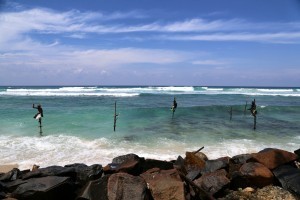 Survivor, Sri Lanka By Paul A. Freitas
Survivor, Sri Lanka By Paul A. Freitas
Have you ever wanted to go somewhere that you have never been but have no idea which destination to choose? You just point to a place on the map and go right? This is exactly how I ended up white knuckling the rear door handle of a car in downtown Colombo, Sri Lanka. From the moment I crossed the threshold at Bandaranaike International Airport into the oppressively heavy air of Sri Lanka, the world blurred and moved in fast forward. I was led to the taxi that would take me to my first stop of the trip and we were under way. Three minutes into the ride, I was thankful for a driver that knew what he was doing. I could instantly see opportunities for death around every turn were the streets filled with tourists. Instead, they were filled with tuk-tuks. These are three wheeled motorcycle cars that are more affordable than your everyday sedan yet much less stylish. Colombo is also where I learned that a 125cc motorcycle doubled as a vehicle for a family of four with an age range from three to seven years old. Oddly enough, only the adults seemed to wear helmets.
About a 55 minute drive from the airport, and I reached the hotel, though I planned for a five minute drive thanks to the person on the phone. Due to the miscalculation, five minutes of overly hot water and a towel that would not get me dry no matter how hard I tried and was on the road again. My destination was Yala National Park on the eastern side of the Sri Lanka. As I settled in for the seven hour drive, I felt adrenaline slow, adjusting to the speed of things happening around me. Thanks to my driver giving me the grand coastal tour however, seven hours was another major miscalculation.
Our first stop was at the sea turtle hospital in Galle. Sri Lanka is home to five of the seven recognized species of sea turtles. The shelter finds the eggs, hatches them in a safe location, and returns the babies to the ocean to avoid people poaching the eggs. There were also several injured turtles that had been saved from nets and boat accidents in the tanks.
From here, it was on to our next stop just south of Galle where I got to photograph the Sri Lankan stilt fishermen (see image below). These fishermen wake up every day and swim out to their stilts (sticks entrenched into the sea floor) where they sit and fish for coral fish. The cousin of the men said that these stilts were handed down from father to son for generations. While the fish do not fetch an incredible amount of money at market, they are food enough to feed the family. I finished photographing and was back in the taxi for the duration of the trip to Yala.
Upon arriving in Yala, I met with my camping host and tour guide. Though I was late by three hours, they decided there was still enough light for an evening animal safari. It was on this safari that I viewed my first ever wild “big cat”, the leopard. Yala National Park is home to one of the largest populations of leopards in the world. While this statement makes it sound like leopards are in great abundance, the truth of the matter is that Yala has approximately 35 leopards, truly sad for being one of the largest leopard populations in existence. The next few days of my trip were spent roaming through Yala National Park to see and photograph many of the various types of flora and fauna.
As my time drew to an end, I was able to visit Udawalawe National Park. Udawalawe has a reputation for its vast numbers of Sri Lankan Asian elephants (200+). I was also fortunate enough to visit the Elephant Transit Home Orphanage. The orphanage is home to juvenile abandoned elephants that are found and reported from all corners of the island. The elephants are raised and encouraged to refine their natural instincts until they are old enough to be released back into the park. Upon release, they are collared with giant radio transmitters to ensure that they are adapting to their new life in the wild.
While I was sad to depart from my new friends and Sri Lanka, visiting truly made me appreciate the things that I have. Sri Lanka is seemingly a poor country. Though its citizens make do, I could see that it was a very hard way of life. All of the people welcomed me with open arms and lots of food! From not knowing where to go, to not wanting to leave, Sri Lanka definitely ranks within my top 10 list of amazing destinations.
About the Author: Paul Freitas is from Salem, Oregon in the United States but has been working as a contractor in Afghanistan for the last 4.5 years. He is currently attending classes for travel photography at MatadorU and is also working towards a degree. He can be reached on Facebook at or on Twitter.
The post Survivor, Sri Lanka appeared first on We Said Go Travel.
12 Must-Experience Tonga Moments, Part 2
Smiles are the currency of Tonga.
The man with the battered boom box wore one as he swayed to a steel drum beat. Grinning at nothing in particular, one hand held the portable machine while the other slapped out a rhythm on his thigh.
“Hey prince, hey princess,” he called out to us, “welcome to paradise!”
The shop keeper across the street thought he was crazy. While my boyfriend and I payed for dusty supplies – bottled water and batteries from China – she smirked bemusedly. “Every day the same…”
Still grooving, he shouted again as we stepped back into the harsh sun. “We got the beach, we got the sea, we got everything we need. This is the real paradise.”
Though Tonga has a high unemployment rate, basic necessities are limited, and the country doesn’t even appear on most world maps, sour faces are a rarity. Once called ‘The Friendly Isles’, this is the only South Pacific country to escape colonization. So while it seems under-developed on the surface, Tonga is rich in less tangible qualities: history, environment, morale.
To capture the wealth of this remote country, here are six more moments you must experience in Tonga:
7. Eat an umu. Prepared across the South Pacific, from New Zealand to Hawaii, this Polynesian meal is cooked in the ground. Basic ingredients – fish, chicken or pork, the starchy taro root, sweet potatoes – are laid over taro leaves (or foil, in the modern version). Next, the raw mixture is drenched with coconut milk. The package of food is then placed in a pit with hot coals and covered up for an hour or two. Most Tongans prepare an umu on Sundays, so it can slowly roast while they attend church. Ask your hostel or guesthouse if they can show you how this traditional meal is created.
8. Try ota ika.
Trevally and the sword-nosed Marlin are prize fish caught off Tonga’s shores. While anglers come for the chance to reel in one of these giants, the daily fish markets showcase a plethora of smaller ocean creatures. A national dish, called ota ika – literally, “raw fish” – features diced fresh seafood, mixed with finely-chopped tomato, onion, coconut and lime juice.
9. Ponder the Trilithon.
Little is known about the ancient stone Trithalon that towers vigilantly from a lonely square of grass on Tongatapu’s northern coast. Though the Stonehenge-like structure has been dated to the 13th century, the facts of its existence are few and hypothetical. Common myth holds that the three stones are too large for human movement and can only have been placed by the Polynesian demigod, Maui.
10. C ut down a coconut.
The local boys make it look easy, shimmying up a narrow palm tree as if they were climbing stairs. While the ascent requires a bit of upper-arm strength and dexterity, it’s a worthy effort for the fruit clustered at the top. The smaller, green coconuts are young and better for milk; older, tougher nuts provide the best flesh. To open, find something sharp, like a rock or strong stick, and poke through one of the nut’s three natural ‘eyes’. In this conservative country, it’s one of the few things you’re allowed to drink in excess.
11. Take the ferry.
Don’t Google it first: news of the 2009 disaster, when the MV Princess Ashika sank and 74 persons were lost at sea, will worry even the bravest travelers. But sailing conditions have improved with foreign investment, and the ferry remains the most authentic way to move between islands. An airplane might be faster – the boat ride between Tonga’tapu and its outer chains can take anywhere from three days to a week – but it doesn’t involve a hundred crates of carefully stacked brown eggs, irate piglets and squabbling hens, bunches of cassava, and locals napping with their bare toes in your lap. Besides, isn’t the journey more important than the destination?
12. Find your own tropical paradise.
With over 170 islands – less than half of them populated – strung like an unclasped pearl necklace from the northern Niuas down to ‘Eua, you don’t have to go far to find an unoccupied stretch of sand. In most instances of accommodation, the title ‘remote resort’ has less to do with starred amenities and more to do with the utter relaxation you’ll receive. No electricity, no running water. Palm-thatched shacks and sea-side hammocks. Fresh coconuts for breakfast, the sunrise as your only alarm. Most importantly, spending time in a place where the only footprints on the beach are your own.
Ticked off all these opportunities on your To-Do Tonga list? Check out even more Must-Experience Moments in Part 1
The post 12 Must-Experience Tonga Moments, Part 2 appeared first on We Said Go Travel.
September 28, 2013
Wakayama: Japan’s Pacific Coast Pearl
Tourists to Japan’s main island, Honshu, tend to gravitate to major cities such as Tokyo and Osaka, or historic sites such as Hiroshima, Nagasaki and Kyoto. Understandably so. The cities are rich and varied in both cuisine and culture. You name it, you will find it.
But what about the lesser known areas of the great Pacific island? The areas overshadowed by the glistening shells of the hot spots?
Wakayama, a prefecture located on the Kii Peninsula of Honshū island, is one such pearl. In addition to stunning Pacific coast scenery, the peninsula touts a National Park, an ancient pilgrimage trail through a winding mountain range, waterfalls, and a myriad of rock formations. The region is easily accessible via the JR train line from any major station.
I’ve highlighted four must-see areas within one short train ride of each other. The colors of the forests and scenery change beautifully with the seasons, making Wakayama a recommendable travel choice year round.
Dorokyo Gorge
Start off with a Dorokyo Gorge Jet Boat tour along the Kitayama-gawa River of Yoshino-Kumano National Park. The Gorge is famous for its sheer rock walls, blue-green waters and steep cliffs.
Kumano Kodo and the Nachi Falls
Often referred to as the spiritual heartland of Japan, the ancient Kumano region is nestled in the mountains of Wakayama. Kumano Kodo is a hiking route made up of seven trails that snake through the Kii Mountain Range. The hike was originally an ancient pilgrimage leading to three major Japanese shrines: Hongu Taisha, Nachi Taisha and Hayatama Taisha.
Hike the peaceful trail to Nachi Falls to see ancient temples, scenic valleys, lush plantlife, and relatively unknown waterfalls.
Kushimoro
Take a train to nearby Kushimoto, located on the southern tip of the Kii Peninsula. The small town and its surroundings feature stunning coastal scenery and unique rock formations that electrify in the sunset.
Shirahama
Head to this white sand beach on Japan’s Izu peninsula, a short and easy train ride from Kushimoro. One of Izu’s most famous and popular sand beaches, it is known for good surfing conditions and the Shinto shrine of Shirahama Jinja. Travelers will find the perfect combination of recreation and relaxation here.
For information on getting to and around Wakayama, check out these related articles and resources:
http://travel.cnn.com/10-things-know-about-wakayama-243956
http://www.wakayamakanko.com/eng/
The post Wakayama: Japan’s Pacific Coast Pearl appeared first on We Said Go Travel.
Spontaneity and Romance on Turkey’s Turquoise Coast
I met John on a hot May night in a dive bar in Washington, DC, where we got into an argument about the Middle East. I had studied in Jordan, then worked there the next year, cultivating inspiring friendships and collecting rosy memories. He had worked in Pakistan during that same year, cultivating food poisoning and collecting less rosy memories. But opposites attract, and soon we were eating mussels and bonding over jukebox picks.
I didn’t know what to think about him at first, but travel makes the heart grow fonder, (or at least shows you the ins and outs of someone really quickly), so when he said he had to go to Turkey the next day and asked if I wanted to join, I said yes. Crazy? A little. But I’ve always been spontaneous and there was something intriguing about his convictions.
The next week was one of the best of my life. We road tripped through Turkey, from Istanbul, to Ephesus, wandering through history, then down the Turqoise coast, stopping in beach towns along the way. Hours driving through mountains lent themselves to intelligent conversation fueled by debate. Though we argued, our similarities struck me, and I was charmed when there wasn’t a trace of ignorance in his retorts, and all the sincerity in the world in his sweetness. By the time we reached Ölüdeniz, I was hooked.
On a boat trip through blue-green water, I told myself to take a deep breath and calm my hopes and heart. I dove into the clear, cool sea, reminding myself that whirlwind romances and lavish vacations are the stuff of dreams and movies, not meant to last through summer. Yet, as we sailed through lush coves and took a hike through the butterfly valley, the early summer heat making my face flush, my damp hair sticking to my neck and the scent of sunblock and wildflowers permeating the air, it was clear I couldn’t control my emotions, rushing faster than the waterfall we climbed to see.
Turkey is a stunning place. One of oriental magic, intense purple sunsets, and relaxing bliss. I was in awe of the water’s intense crystal blue, in awe of butterflies flitting through the meadow, and in awe of this guy who succeeded in sweeping me off my feet in a matter of hours.
He told me he loved me on night three, only four days after we met. Could it have been the vacation talking? I hoped not. Now, one year later, long after the tan has faded, the serenity of that clear, clear water has left my dreams, and the splendor of the blue mosque shines only through photos, he’s still here, laughing about our whimsical start and keeping my Mid East obsession in check. A photo of Ölüdeniz hangs on our refrigerator in Rome, where we’re starting a life of adventure together. A life of love and beauty, a life of spontaneity and new experiences, and of course, a life of travel and taking chances, for where would we be without that?
About the Author: Her roots are in Wisconsin, but Rebecca Holland has backpacked through Asia and lived in the Middle East, and is currently working in Italy as a freelance journalist and travel writer. Visit her blog, CuriosityandaCarryOn, and join her on twitter at @globalmusings.
The post Spontaneity and Romance on Turkey’s Turquoise Coast appeared first on We Said Go Travel.
We Said Go Travel
We Said Go Travel is a global community of over sixteen hundred writers with articles from every continent.
Stories are shared with photos and video from a perspective of the transformative power of travel. We Said Go Travel has hosted live and online events as well as travel writing contests around the world. ...more
- Lisa Niver's profile
- 57 followers


